Dighton Rock – Centuries-Old-Mystery Still Unsolved
A. Sutherland - AncientPages.com - Dighton Rock has been a subject of intense debate, curiosity, and wonder for centuries.
It’s a rock with a mysterious past we are unable to decipher. Its cuneiform-style inscriptions have long intrigued and puzzled observers and researchers.
A 40-ton boulder is a slanted, six-sided block approximately 5 feet (1.5 m) high, 9.5 feet (2.9 m) wide, and 11 feet (3.4 m) long.
It was found partially submerged on the Taunton River at Berkley, Massachusetts (formerly part of the town of Dighton).
Covered with petroglyphs and carved designs of ancient and uncertain origin, the rock is now installed in a memorial building nearby in Berkley.
In his book, “The Wonderful Works of God Commemorated,” published in 1690, the Rev. Cotton Mather gave this description:
"Among the other Curiosities of New-England, one is that of a mighty Rock, on a perpendicular side whereof by a River, which at High Tide covers part of it, there are very deeply Engraved, no man alive knows How or When about half a score Lines, near Ten Foot Long, and a foot and half broad, filled with strange Characters: which would suggest as odd Thoughts about them that were here before us, as there are odd Shapes in that Elaborate Monument.."
Over the last three centuries, people were making a series of accusations about the origins of the rock. More than 20 theories have been proposed about its origins Ezra Stiles (1727 -1795), an American academic, theologian and author, was convinced the rock was carved by ancient Phoenicians.
Some speculated that the Vikings or Native Americans did it; others credited early Portuguese explorers with the Dighton Rock inscription.
In 1784, Count Antoine Court de Gobelin, a French nobleman, suggested that Dighton Rock commemorated a visit to the Massachusetts shore “in very ancient times” by a group of sailors from Carthage on the shores of the Mediterranean.
In 1807, Samuel Harris, a Harvard scholar, claimed that he had deciphered three ancient Hebrew words in Phoenician lettering — “king,” “priest” and “idol.”

In 1963, the rock was removed from the river and installed in a museum in the Dighton Rock State Park. In 1980 it was listed on the National Register of Historic Places. Credit: Marcbela - CC0
In 1831, Ira Hill, a schoolteacher from Maryland, claimed he had deduced from the Old Testament that the rock was engraved “in the second month in the tenth year of the reign of King Solomon by an expedition of Tyrians and Jews …”
In his book "1421: The Year China Discovered the World" published in 2002, Gavin Menzies proposes that the Chinese left the inscription for us, when they reached America 70 years before Columbus.
We can only say that despite a few hundred years of speculation, the extensive petroglyphs on the rock have still not been explained conclusively.
The Dighton Rock still puzzles us because its mysterious hieroglyphs have not been deciphered.
Written by – A. Sutherland - AncientPages.com Senior Staff Writer
Updated on July 3, 2024
Copyright © AncientPages.com All rights reserved. This material may not be published, broadcast, rewritten or redistributed in whole or part without the express written permission of AncientPages.com
Expand for referencesReferences: Dighton Rock
David Goudsward, "Ancient Stone Sites Of New England And The Debate Over Early European Exploration"
More From Ancient Pages
-
 Brokkr And Eitri – Norse Dwarves Who Fashioned Magical Artifacts For The Gods
Featured Stories | Aug 19, 2019
Brokkr And Eitri – Norse Dwarves Who Fashioned Magical Artifacts For The Gods
Featured Stories | Aug 19, 2019 -
 Mystery Of The Patagonian Giants: Europe’s Lost Race From The ‘Land Of The Bigfeet’
Featured Stories | Jun 20, 2020
Mystery Of The Patagonian Giants: Europe’s Lost Race From The ‘Land Of The Bigfeet’
Featured Stories | Jun 20, 2020 -
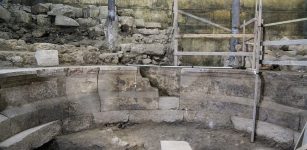 Roman Theater Unearthed After 1,700 Years Near Western Wall In Jerusalem
Archaeology | Oct 19, 2017
Roman Theater Unearthed After 1,700 Years Near Western Wall In Jerusalem
Archaeology | Oct 19, 2017 -
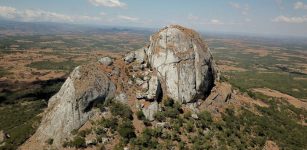 Ancient DNA Reveals Surprises About Life Of Early Africans
Archaeology | Feb 24, 2022
Ancient DNA Reveals Surprises About Life Of Early Africans
Archaeology | Feb 24, 2022 -
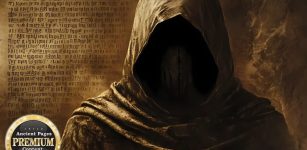 Mysterious Ancient European Cloaked Individuals – Who Were These Perplexing Beings?
Featured Stories | Mar 15, 2025
Mysterious Ancient European Cloaked Individuals – Who Were These Perplexing Beings?
Featured Stories | Mar 15, 2025 -
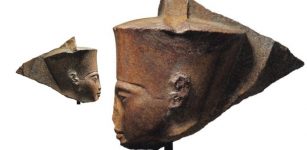 Egypt Calls On Christie’s Auction House In London To Stop Sale Of Tutankhamun Statue Head
Archaeology | Jun 14, 2019
Egypt Calls On Christie’s Auction House In London To Stop Sale Of Tutankhamun Statue Head
Archaeology | Jun 14, 2019 -
 Huge Ancient Ceramic Workshop With Hundreds Of Stunning Artifacts Solves An Archaeological Mystery In Israel
Archaeology | Dec 14, 2020
Huge Ancient Ceramic Workshop With Hundreds Of Stunning Artifacts Solves An Archaeological Mystery In Israel
Archaeology | Dec 14, 2020 -
 A Magical Handbook For The Afterlife – Insights To Ancient Egyptian Religion, Magic And Secret Knowledge
News | Jul 11, 2023
A Magical Handbook For The Afterlife – Insights To Ancient Egyptian Religion, Magic And Secret Knowledge
News | Jul 11, 2023 -
 World’s Oldest Marine Navigation Tool Was A Sophisticated Astrolabe
Archaeology | Oct 25, 2017
World’s Oldest Marine Navigation Tool Was A Sophisticated Astrolabe
Archaeology | Oct 25, 2017 -
 Mystery Of The Kusanagi Treasure: The Legendary Sword
Artifacts | Feb 8, 2016
Mystery Of The Kusanagi Treasure: The Legendary Sword
Artifacts | Feb 8, 2016 -
 Norse Religion Was Different Than Previously Thought – New Study Reveals
Archaeology | Feb 27, 2021
Norse Religion Was Different Than Previously Thought – New Study Reveals
Archaeology | Feb 27, 2021 -
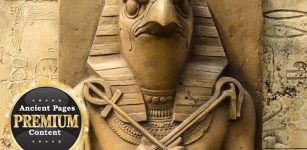 Mysterious Shemsu Hor – Followers Of Horus Were Semi-Divine Kings And Keepers Of Sacred Knowledge In Predynastic Egypt
Ancient Mysteries | May 15, 2017
Mysterious Shemsu Hor – Followers Of Horus Were Semi-Divine Kings And Keepers Of Sacred Knowledge In Predynastic Egypt
Ancient Mysteries | May 15, 2017 -
 1,800-Year-Old Legio VI Ferrata Military Camp Uncovered In Israel
Archaeology | Feb 21, 2024
1,800-Year-Old Legio VI Ferrata Military Camp Uncovered In Israel
Archaeology | Feb 21, 2024 -
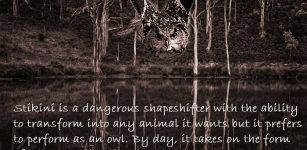 Stikini ‘Man-Owl’ – Sinister Vampiric Monster That Works In Disguise
Featured Stories | Jan 29, 2019
Stikini ‘Man-Owl’ – Sinister Vampiric Monster That Works In Disguise
Featured Stories | Jan 29, 2019 -
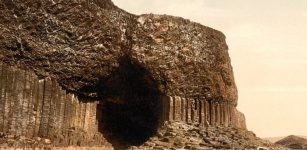 Natural Wonders: ‘Fingal’s Cave’ – An Enigmatic Place Shrouded In Mystery And Legend
Featured Stories | Mar 18, 2023
Natural Wonders: ‘Fingal’s Cave’ – An Enigmatic Place Shrouded In Mystery And Legend
Featured Stories | Mar 18, 2023 -
 Immortal Mimi Spirits In Beliefs Of Aborigines Of Arnhem Land
Featured Stories | Mar 26, 2020
Immortal Mimi Spirits In Beliefs Of Aborigines Of Arnhem Land
Featured Stories | Mar 26, 2020 -
 Little Known History Of Amazon’s Ashaninka People Studied By Researchers
Archaeology | Mar 21, 2023
Little Known History Of Amazon’s Ashaninka People Studied By Researchers
Archaeology | Mar 21, 2023 -
 Researchers Study Human Mobility At The Bronze Age City Of Alalakh, Turkey
Archaeology | Jul 1, 2021
Researchers Study Human Mobility At The Bronze Age City Of Alalakh, Turkey
Archaeology | Jul 1, 2021 -
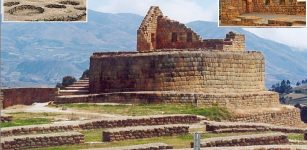 Ancient Ingapirca: Largest And Best Preserved Inca Ruins In Ecuador
Civilizations | Dec 9, 2016
Ancient Ingapirca: Largest And Best Preserved Inca Ruins In Ecuador
Civilizations | Dec 9, 2016 -
 A Rare 1,500 Year Old Mosaic That Depicts Ancient Streets And Buildings in Egypt – Discovered
News | Sep 29, 2015
A Rare 1,500 Year Old Mosaic That Depicts Ancient Streets And Buildings in Egypt – Discovered
News | Sep 29, 2015



